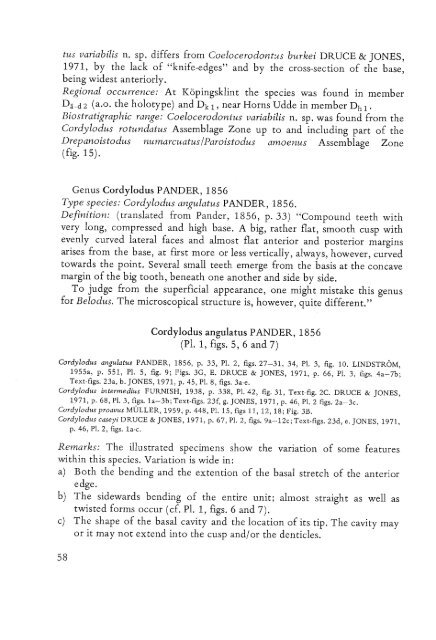UTRECHT MICROPALEONTOLOGICAL BUllETINS
UTRECHT MICROPALEONTOLOGICAL BUllETINS
UTRECHT MICROPALEONTOLOGICAL BUllETINS
You also want an ePaper? Increase the reach of your titles
YUMPU automatically turns print PDFs into web optimized ePapers that Google loves.
tus variabilis n. sp. differs from Coelocerodontus burkei DRUCE & JONES,<br />
1971, by the lack of "knife-edges" and by the cross-section of the base,<br />
being widest anteriorly.<br />
Regional occurrence: At Kopingsklint the species was found in member<br />
Da-d2 (a.o. the holotype) and Dk 1, near Horns Udde in member D h l'<br />
Biostratigraphic range: Coelocerodontus variabilis n. sp. was found from the<br />
Cordylodus rotundatus Assemblage Zone up to and including part of the<br />
Drepanois to dus numarcuatus/Paroistodus amoenus Assemblage Zone<br />
(fig. 15).<br />
Genus Cordylodus PANDER, 1856<br />
Type species: Cordylodus angulatus PANDER, 1856.<br />
Definition: (translated from Pander, 1856, p.33) "Compound teeth with<br />
very long, compressed and high base. A big, rather flat, smooth cusp with<br />
evenly curved lateral faces and almost flat anterior and posterior margins<br />
arises from the base, at first more or less vertically, always, however, curved<br />
towards the point. Several small teeth emerge from the basis at the concave<br />
margin of the big tooth, beneath one another and side by side.<br />
To judge from the superficial appearance, one might mistake this genus<br />
for Belodus. The microscopical structure is, however, quite different."<br />
Cordylodus angulatus PANDER, 1856<br />
(PI. 1, figs. 5, 6 and 7)<br />
Cordylodus angulatus PANDER, 1856, p. 33, PI. 2, figs. 27-31, 34, PI. 3, fig. 10. LINDSTROM,<br />
1955a, p. 551, PI. 5, fig. 9; Figs. 3G, E. DRUCE & JONES, 1971, p. 66, PI. 3, figs. 4a-7b;<br />
Text-figs. 23a, b. JONES, 1971, p. 45, PI. 8, figs. 3a-e.<br />
Cordylodus intermedius FURNISH, 1938, p. 338, PI. 42, fig. 31, Text-fig. 2C. DRUCE & JONES,<br />
1971, p. 68, PI. 3, figs. la-3b; Text-figs. 23f, g. JONES, 1971, p. 46, PI. 2 figs. 2a-3c.<br />
Cordylodus proavus MULLER, 1959, p. 448, PI. 15, figs 11, 12, 18; Fig. 3B.<br />
Cordylodus caseyi DRUCE & JONES, 1971, p. 67, PI. 2, figs. 9a-12c; Text-figs. 23d, e. JONES, 1971,<br />
p. 46, PI. 2, figs. la-c.<br />
Remarks: The illustrated specimens show the variation of some features<br />
within this species. Variation is wide in:<br />
a) Both the bending and the extention of the basal stretch of the anterior<br />
edge.<br />
b) The sidewards bending of the entire unit; almost straight as well as<br />
twisted forms occur (cf. PI. 1, figs. 6 and 7).<br />
c) The shape of the basal cavity and the location of its tip. The cavity may<br />
or it may not extend into the cusp and/ or the denticles.
















